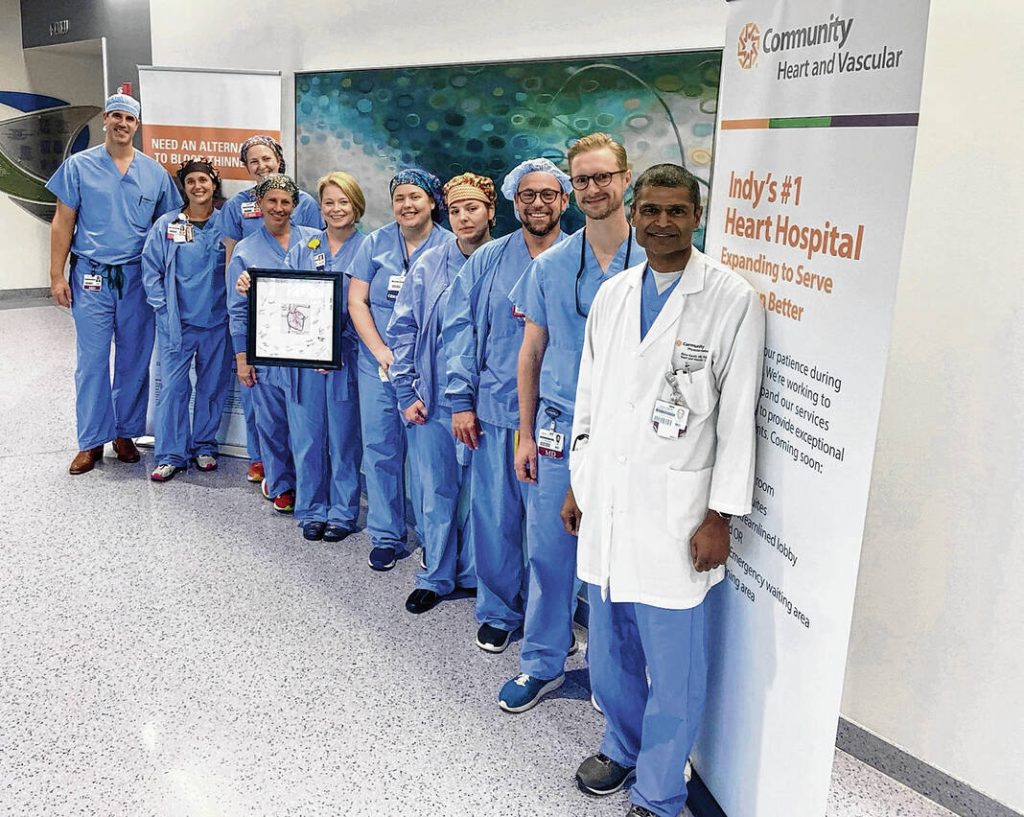Like a ticking time bomb, a deadly malady waits inside thousands of Indiana patients.
People with non-valvular atrial fibrillation know that they have a common heart rhythm disorder and that the issue can lead to blood clots and increase the likelihood of a stroke.
Until now, the treatments have been regular use of blood thinners, or invasive open heart surgery. But a new medical innovation has given Community Health Network patients hope for less risk and better results.
The health care system is the first in Indiana to successfully implant the WATCHMAN FLX Pro device, which reduces the risk of stroke in patients with non-valvular atrial fibrillation.

Rather than keeping those patients on blood thinners long-term, the device corrects the rhythm disorder more safely and quickly than ever before, said Dr. Krishna Malineni, a board-certified cardiologist at Community Health Network.
“For patients who have been at risk from bleeding from falls and injuries, it’s wonderful to be able to tell them that they can stop blood thinners and don’t have to be as scared of having a stroke,” he said. “If we can tell them we can reduce their risk of stroke by 80 to 90% without using blood thinners, that’s a huge weight off their shoulders.”
The WATCHMAN FLX Pro was developed by Boston Scientific, one of the world’s top global medical technology companies. Cardiologists use it to seal the left atrial appendage, a small sac in the muscle wall of the top left chamber of the heart.
This sac is where a vast majority of stroke-causing blood clots form and enter the bloodstream, Malineni said.
“We’re all born with this area of the heart, but it’s not essential for heart function. That’s where 80 to 90% of the risk of stroke is conferred from that area,” he said.
To help people visualize it, Malineni described the appendage as a small closet without a door.
“That small closet without a door is where blood can pool and clot,” he said. “So we want to close it off from the circulation and not let any clots get out.”
Non-vascular atrial fibrillation is becoming increasingly common, with at least 3 to 6 million people impacted by it, and those numbers are projected to reach about 6 to 16 million by 2050, according to the Circulation Research, a medical journal from the American Heart Association.
Blood thinners remain the primary treatment for these patients to prevent strokes, Malineni said. But those medications are not ideal for some atrial fibrillation patients, such as those who have a prior history of gastrointestinal bleeding, prior brain bleeds, risk of frequent falls and individuals in high-risk professions, such as police officers, firefighters and military personnel.
“For these individuals, we’re trying to weigh the risk-benefit of being on the blood thinners vs. risk of stroke, and see what the options were,” Malineni said. “Before the WATCHMAN, for some of these patients, we just had to tell them they had to accept the risk of stroke and be on blood thinners.”
The WATCHMAN device was developed as an alternative to open-heart surgery, which carries with it significant risk and recovery time. Used first in Europe, the device was approved by the Food and Drug Administration in 2016 to employ in the United States.
Cardiologists use X-rays to determine the size and scope of the left atrial appendage in individual patients, and then fit the WATCHMAN device on it to close that opening.
By reducing the risks a clot-caused stroke, doctors can reduce the use of long-term blood thinners. Patients require less frequent monitoring and potential bleeding complications associated with those thinners.
Community Health has used different iterations of the device since 2016. The WATCHMAN FLX Pro is the latest iteration and offers advantages such as further reducing the risk of clotting on the device itself and less inflammation.
“Through our commitment to exceptional care and innovation, Community has earned a reputation as the go-to healthcare system for training future implanters,” said Dr. Michael Robertson, interventional cardiologist for Community Health Network. “This distinction sets our program apart, assuring our patients that we not only perform these procedures safely, but consistently achieve outstanding results.”
The WATCHMAN FLX Pro was approved in October, and Community Health performed the first procedures using it in late October. Hospital officials anticipate it to become even more useful to patients throughout the Indianapolis area, including Johnson County.
“We’re excited about better technology leading to better care for our patients and better results,” Malineni said.





